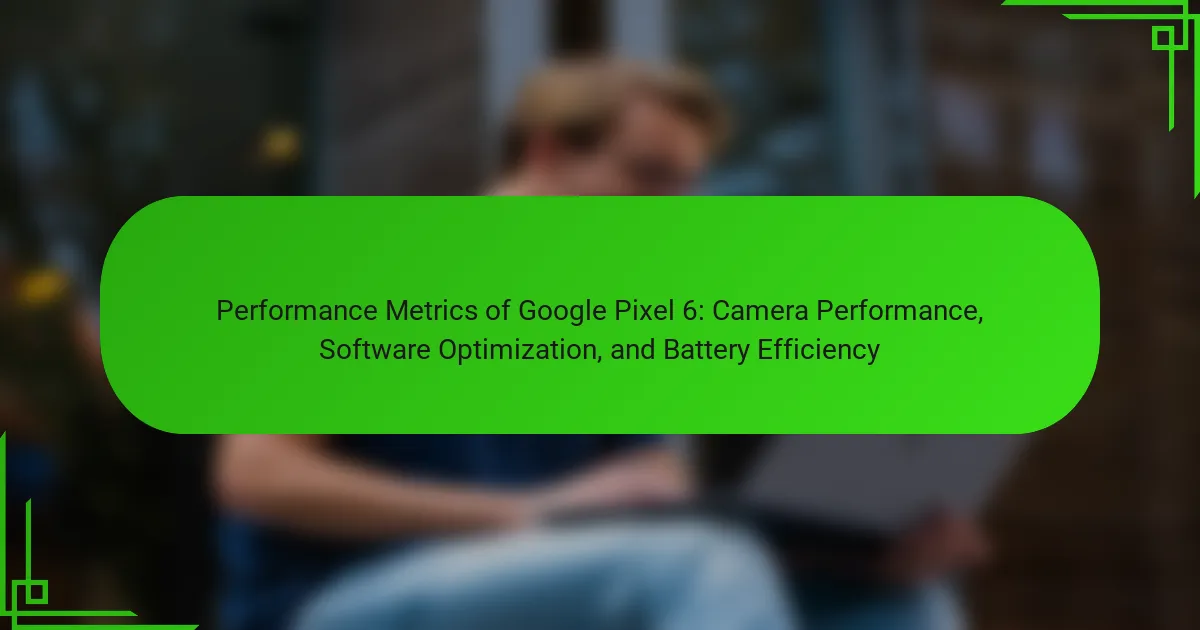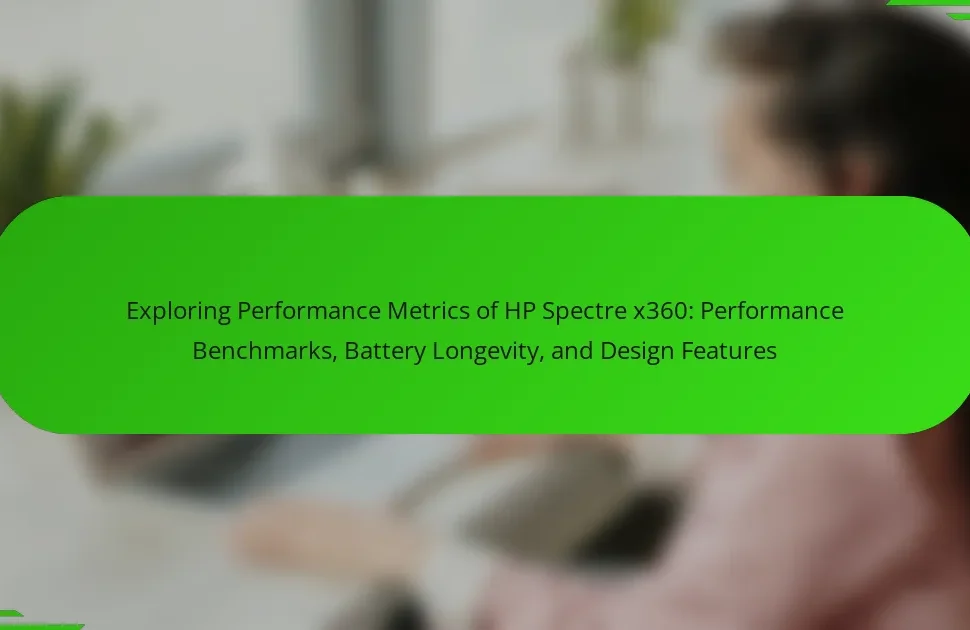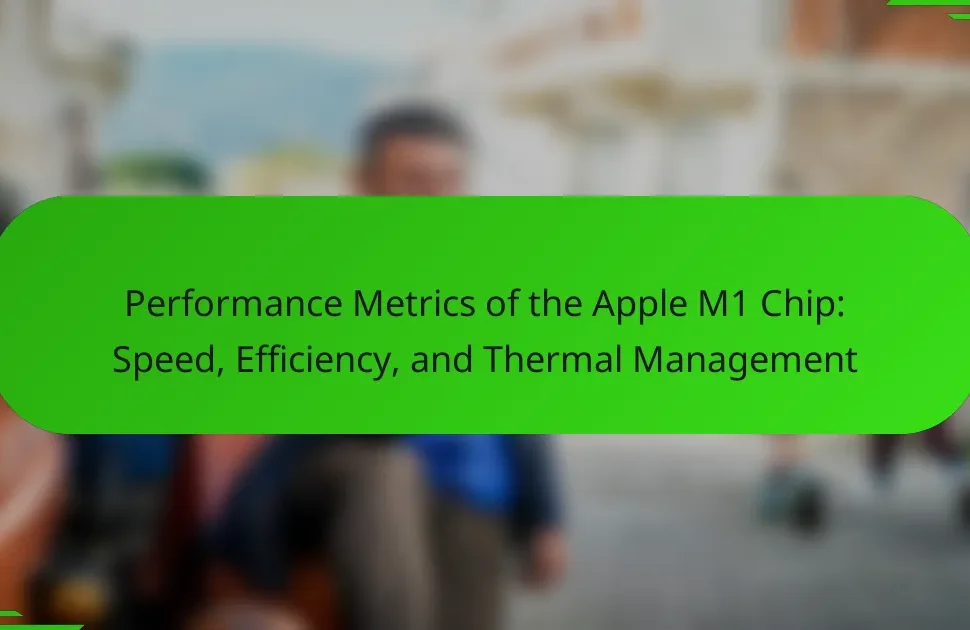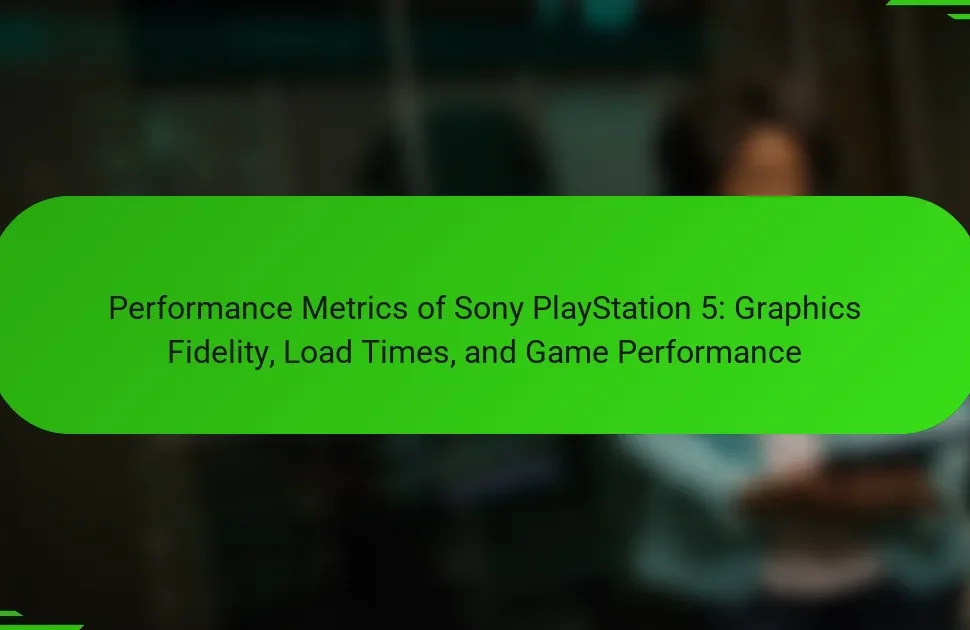The Google Pixel 6 is a smartphone that showcases advanced performance metrics, focusing on its processor, RAM, camera capabilities, and battery life. Powered by the Google Tensor chip, the device achieves enhanced processing speed and efficiency, supported by 8 GB of RAM for smooth multitasking. Its camera system features a 50 MP wide lens and a 12 MP ultra-wide lens, ensuring high-quality image capture. With a battery capacity of 4614 mAh, the Google Pixel 6 offers all-day usage, while software optimization improves performance in photography and app responsiveness, ultimately enhancing the overall user experience.

What are the key performance metrics of the Google Pixel 6?
The key performance metrics of the Google Pixel 6 include its processor, RAM, camera capabilities, and battery life. The device is powered by the Google Tensor chip, which enhances processing speed and efficiency. It features 8 GB of RAM, allowing for smooth multitasking. The camera system includes a 50 MP wide lens and a 12 MP ultra-wide lens, delivering high-quality images. Battery capacity is rated at 4614 mAh, providing all-day usage. The software optimization enhances performance, especially in photography and app responsiveness. These metrics collectively contribute to the overall user experience of the Google Pixel 6.
How does the camera performance of the Google Pixel 6 compare to other smartphones?
The camera performance of the Google Pixel 6 is highly regarded in comparison to other smartphones. It features a 50 MP main sensor, which captures detailed images with vibrant colors. The Pixel 6 excels in low-light conditions due to its advanced Night Sight mode. This mode allows for impressive photo quality even in dim environments. Additionally, the device benefits from Google’s computational photography algorithms. These algorithms enhance image processing, resulting in clearer and more dynamic photos.
When compared to flagship models from competitors, the Pixel 6 often matches or exceeds camera quality. For example, it competes closely with the iPhone 13 and Samsung Galaxy S21 in various camera tests. In independent evaluations, the Pixel 6 has received high scores for its overall camera performance. Its ability to produce high-quality images consistently sets it apart in the smartphone market.
What are the specifications of the Google Pixel 6 camera?
The Google Pixel 6 camera features a 50 MP wide lens. It also includes a 12 MP ultra-wide lens. The camera system is equipped with advanced computational photography capabilities. It supports Night Sight for low-light conditions. The camera can record 4K video at 60 frames per second. It features optical image stabilization for clearer images. The front camera is 8 MP, suitable for selfies and video calls. These specifications contribute to the overall performance of the Google Pixel 6 camera.
How does the camera software enhance image quality?
Camera software enhances image quality through advanced algorithms and processing techniques. These algorithms improve color accuracy and dynamic range. Software features like HDR (High Dynamic Range) capture more detail in highlights and shadows. Noise reduction algorithms minimize graininess in low-light conditions. Image stabilization software reduces blurriness from motion. Additionally, computational photography techniques enhance details and textures. The Google Pixel 6 utilizes machine learning to optimize images based on scene recognition. This results in sharper, more vibrant photos compared to standard processing methods.
What role does software optimization play in the Google Pixel 6’s performance?
Software optimization significantly enhances the Google Pixel 6’s performance. It ensures efficient resource management, leading to faster app launches and smoother multitasking. The integration of machine learning algorithms optimizes camera functions, improving image processing and low-light performance. Additionally, software updates provide performance enhancements and security fixes, maintaining device efficiency over time. According to Google, the Pixel 6’s Tensor chip is designed to leverage software optimization, offering tailored performance for various tasks. This synergy between hardware and software results in a seamless user experience.
How does the Google Pixel 6 utilize AI for software optimization?
The Google Pixel 6 utilizes AI for software optimization through its Tensor chip. This chip enhances processing power and efficiency for various tasks. AI algorithms improve photo processing, enabling features like Night Sight and Magic Eraser. The device also uses AI for adaptive battery management, learning user habits to optimize power usage. Additionally, it employs machine learning for app performance, predicting which apps users will open next. This results in faster load times and smoother multitasking. Overall, the integration of AI in the Pixel 6 leads to a more responsive and efficient user experience.
What are the benefits of software updates for performance enhancement?
Software updates enhance performance by improving system stability and optimizing resource management. They fix bugs that may slow down device operation. Updates often include new features that can streamline user experience. They also enhance security, protecting the device from vulnerabilities that could impact performance. Additionally, updates can improve battery efficiency, prolonging device usage time. For example, Google regularly releases updates for the Pixel 6 to optimize its camera and battery performance. These updates ensure that users experience the latest enhancements and fixes, leading to a smoother overall operation.
How efficient is the battery performance of the Google Pixel 6?
The battery performance of the Google Pixel 6 is efficient. It features a 4614 mAh battery capacity. This allows for up to 24 hours of usage on a single charge. The device supports adaptive battery technology. This technology optimizes power consumption based on user habits. Reviews indicate that the Pixel 6 can last a full day with moderate use. Fast charging capabilities enable quick power replenishment. Wireless charging is also supported, adding convenience for users.
What is the battery capacity of the Google Pixel 6?
The battery capacity of the Google Pixel 6 is 4614 mAh. This capacity supports extended usage throughout the day. The Pixel 6 is designed to optimize power consumption with its software. This ensures efficient battery management during various tasks. The capacity allows for fast charging capabilities as well. Overall, the battery size contributes to the phone’s performance metrics.
How does battery optimization affect daily usage?
Battery optimization significantly enhances daily usage by prolonging the device’s operational time. It reduces power consumption through efficient resource management. This leads to fewer instances of charging throughout the day. For example, Google Pixel 6 employs adaptive battery features to prioritize power for frequently used apps. As a result, users experience improved performance and extended usability. Studies show that optimized battery management can increase device longevity by up to 30%. This optimization is crucial for maintaining user satisfaction and device reliability.
How do camera performance and software optimization impact overall user experience?
Camera performance and software optimization significantly enhance overall user experience. High-resolution sensors capture detailed images, while advanced optics improve low-light performance. Software optimization processes images to reduce noise and enhance colors. Features like HDR and portrait mode rely on both hardware and software for optimal results. Fast processing times ensure users can take photos quickly without lag. Regular software updates can improve camera capabilities over time. User satisfaction often correlates with the quality of images produced. According to studies, better camera performance leads to higher user engagement with devices.
What are the common challenges users face with the Google Pixel 6’s performance metrics?
Users commonly face issues with the Google Pixel 6’s performance metrics. One significant challenge is the inconsistent camera performance in low-light conditions. Users report that images can appear grainy or lack detail. Another challenge is software optimization, where some applications may lag or crash unexpectedly. Battery efficiency is also a concern, with users experiencing rapid drainage during heavy usage. Additionally, users note that the device can become warm during extended use, impacting overall performance. These challenges have been documented in user reviews and technology forums, highlighting the need for improvements in these areas.
What tips can improve the performance of the Google Pixel 6?
To improve the performance of the Google Pixel 6, users can optimize settings and manage apps effectively. Disable unused apps running in the background to free up resources. Regularly clear the cache of applications to enhance speed. Keep the device updated with the latest software for better performance and security. Adjust display settings to reduce battery consumption. Use the ‘Battery Saver’ mode during low power situations to extend usage time. Additionally, consider resetting the device to factory settings if performance issues persist. These tips can lead to noticeable improvements in speed and efficiency.
The Google Pixel 6 is a smartphone known for its impressive performance metrics, which include a powerful Google Tensor chip, 8 GB of RAM, and a camera system featuring a 50 MP wide lens and a 12 MP ultra-wide lens. This article examines the device’s camera performance, highlighting its capabilities in low-light conditions and advanced computational photography, as well as the role of software optimization in enhancing overall user experience. Additionally, it discusses battery efficiency, with a 4614 mAh capacity supporting all-day usage, and provides tips for users to improve device performance. Common challenges faced by users, such as inconsistent camera performance and battery drainage during heavy use, are also addressed.




